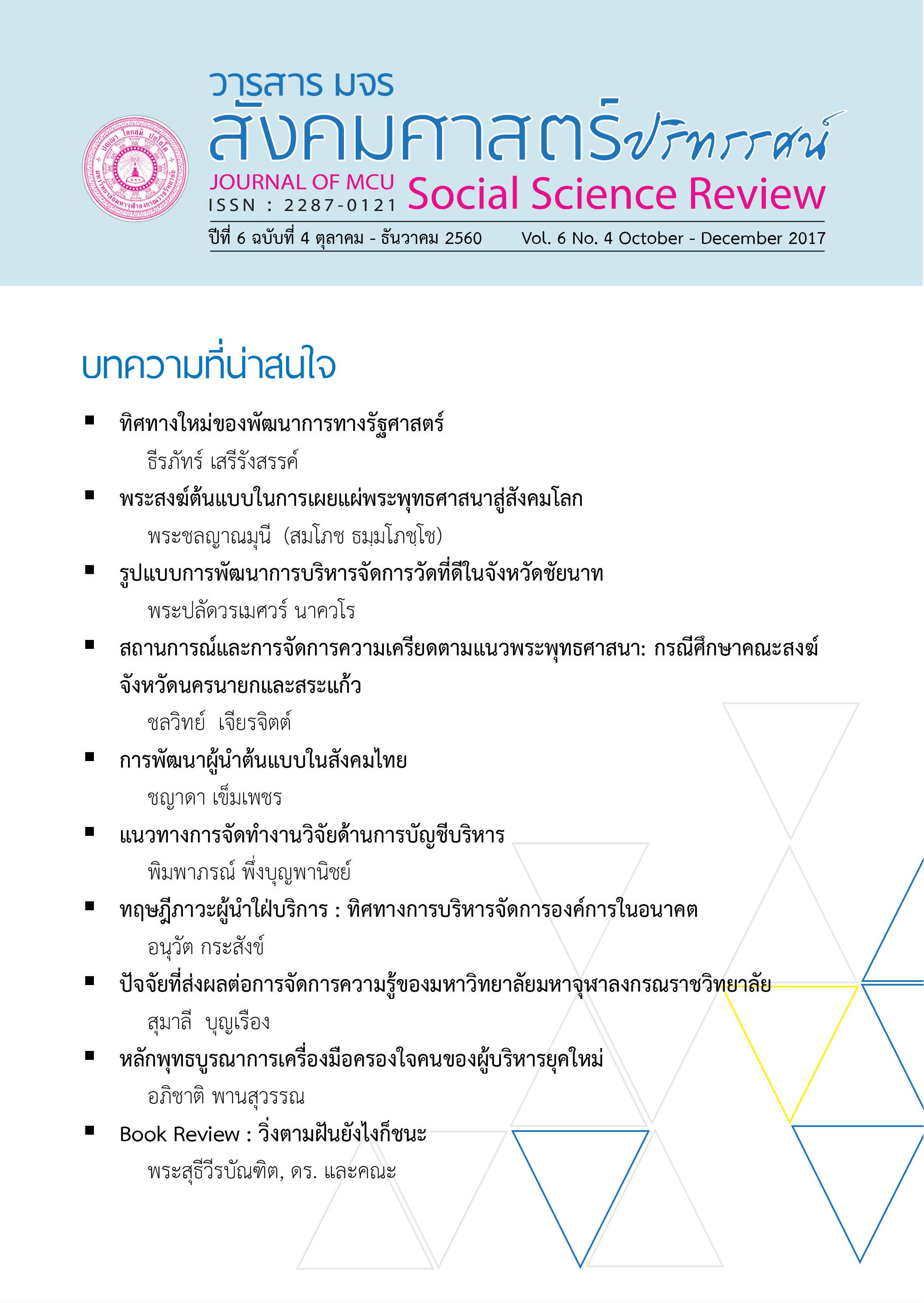วัฒนธรรมองค์การที่มีผลต่อประสิทธิภาพการทำงานของบุคลากร สำนักงานคณะกรรมการป้องกันและปราบปรามการทุจริตแห่งชาติประจำจังหวัด ในเขตภาคตะวันออกเฉียงเหนือ
คำสำคัญ:
วัฒนธรรมองค์การ, ประสิทธิภาพการทำงานของบุคลากร, สำนักงานคณะกรรมการ ป้องกันและปราบปรามการทุจริตแห่งชาติบทคัดย่อ
บทความวิจัยนี้มีวัตถุประสงค์เพื่อ 1) ศึกษาระดับความคิดเห็นเกี่ยวกับวัฒนธรรมองค์กร 2) ศึกษาระดับความคิดเห็นเกี่ยวกับประสิทธิภาพการทำงานของบุคลากร 3) ศึกษาวัฒนธรรมองค์การที่มีผลต่อประสิทธิภาพการทำงานของบุคลากร สำนักงานคณะกรรมการป้องกันและปราบปรามการทุจริตแห่งชาติประจำจังหวัด ในเขตภาคตะวันออกเฉียงเหนือ กลุ่มตัวอย่าง คือ ข้าราชการสำนักงานสำนักงานคณะกรรมการป้องกันและปราบปรามการทุจริตแห่งชาติประจำจังหวัด ในเขตภาคตะวันออกเฉียงเหนือ จำนวน 300 คน เครื่องมือที่ใช้ในการวิจัย คือ แบบสอบถาม สถิติที่ใช้ในการวิเคราะห์ข้อมูล ได้แก่ ความถี่ ร้อยละ ค่าเฉลี่ย ส่วนเบี่ยงเบนมาตรฐาน สถิติ t-test ค่าสัมประสิทธิ์สหสัมพันธ์เพียร์สัน และวิเคราะห์ถดถอยพหุคูณแบบขั้นตอน (Stepwise Multiple Regression Analysis) ที่ระดับนัยสำคัญทางสถิติ .05
ผลการวิจัยพบว่า
1) ระดับความคิดเห็นเกี่ยวกับวัฒนธรรมองค์การของบุคลากร สำนักงานคณะกรรมการป้องกันและปราบปรามการทุจริตแห่งชาติประจำจังหวัด ในเขตภาคตะวันออกเฉียงเหนือ โดยภาพรวมอยู่ในระดับมาก
2) ระดับความคิดเห็นเกี่ยวกับประสิทธิภาพการทำงานของบุคลากร สำนักงานคณะกรรมการป้องกันและปราบปรามการทุจริตแห่งชาติประจำจังหวัด ในเขตภาคตะวันออกเฉียงเหนือ โดยภาพรวมอยู่ในระดับมาก
3) วัฒนธรรมองค์การที่มีผลต่อประสิทธิภาพของบุคลากรสำนักงานคณะกรรมการป้องกันและปราบปรามการทุจริตแห่งชาติประจำจังหวัด ในเขตภาคตะวันออกเฉียงเหนือ พบว่า วัฒนธรรมองค์การ 7 ด้าน กับประสิทธิภาพการทำงานของบุคลากร มีความสัมพันธ์ทางบวกค่อนข้างต่ำถึงค่อนข้างสูง มีค่าอยู่ระหว่าง 0.319 ถึง 0.760 (Rxy = 0.319-0.760) เมื่อวิเคราะห์ถดถอยพหุคูณ วัฒนธรรมองค์การที่มีผลต่อประสิทธิภาพของบุคลากร ด้วยวิธี Stepwise พบว่า มีวัฒนธรรมองค์การ 4 ด้าน ประกอบด้วย วัฒนธรรมพันธกิจ (X4) มืออาชีพ (X7) วัฒนธรรมเอกภาพ (X2) และวัฒนธรรมส่วนร่วม (X1) มีค่าสัมประสิทธิ์สหสัมพันธ์พหุคูณ (R) เท่ากับ 0.854 มีอิทธิพลสามารถอธิบายการเปลี่ยนแปลงของประสิทธิภาพการทำงาน ร้อยละ 73 (R2 = 0730) และมีความคลาดเคลื่อนมาตรฐานในการพยากรณ์เท่ากับ 2.01880 (SEEST=2.01880) โดยสามารถสร้างสมการได้ดังนี้
สมการในรูปคะแนนดิบ :
Y ̂ = 5.259 + 2.038X4 + 2.358X7 + 1.335X2 + 0.589X1
สมการในรูปคะแนนมาตรฐาน :
Z ̂ = 0367Z4 + 0.362Z7 + 0.218Z2 + 0.099Z1
จากสมการแสดงตัวแปรพยากรณ์ที่ดีที่สุด ที่สามารถพยากรณ์ประสิทธิภาพ การทำงานของบุคลากรสำนักงานสำนักงานคณะกรรมการป้องกันและปราบปราม การทุจริตแห่งชาติประจำจังหวัด ในเขตภาคตะวันออกเฉียงเหนือ จำนวน 4 ตัวแปร นั่นคือ วัฒนธรรมพันธกิจ มืออาชีพ วัฒนธรรมเอกภาพ และวัฒนธรรมส่วนร่วม
เอกสารอ้างอิง
Kantaya Phoemphon. (2011). Dfficiency Development. (3nd ed). Bangkok: Rajabhat Institute Suan Disit Book Center.
Krittin Kunpheng. (2012). The Reality Hurts in The HR Jobs. Bangkok: HR Center.
Nonglak Wiratchai. (1999). Mate-Analysis. Bangkok: Chulalongkorn University.
Rangsan Prasoetsee. (2005). Organizational Behavior : Test And Oraganizational Behavior (OB) (Application). Bangkok: Dharmasarn.
Thada Soonchan and Witat Janposri. (2012). Relationships between Organizational Culture in Era of Globalization Perceived by Health Personnel and Performance According to Learning Organization Characteristics of Sub-District Health Promoting Hospital in Sakon Nakhon Province. Journal of the Office of ODPC 6 Khon Kaen 19 (2), 41–54.
Songsak Phuseeorn. (2008). Statistical Package for the Social Sciences. Kalasin: Prasan printing.
Woranat Sangmanee. (2011). Organization and Organizing (3 nd ed). Bangkok: Rabeangthong Printing.
Wuttichat Sunthonsamai. (2009). Maketing Research and Marketing Information System. Bangkok: SE-Education.
ดาวน์โหลด
รูปแบบการอ้างอิง
ฉบับ
ประเภทบทความ
สัญญาอนุญาต
ลิขสิทธิ์ (c) 2017 วารสาร มจร สังคมศาสตร์ปริทรรศน์

อนุญาตภายใต้เงื่อนไข Creative Commons Attribution-NonCommercial-NoDerivatives 4.0 International License.
เพื่อให้เป็นไปตามกฎหมายลิขสิทธิ์ ผู้นิพนธ์ทุกท่านต้องลงลายมือชื่อในแบบฟอร์มใบมอบลิขสิทธิ์บทความให้แก่วารสารฯ พร้อมกับบทความต้นฉบับที่ได้แก้ไขครั้งสุดท้าย นอกจากนี้ ผู้นิพนธ์ทุกท่านต้องยืนยันว่าบทความต้นฉบับที่ส่งมาตีพิมพ์นั้น ได้ส่งมาตีพิมพ์เฉพาะในวารสาร มจร สังคมศาสตร์ปริทรรศน์ เพียงแห่งเดียวเท่านั้น หากมีการใช้ภาพหรือตารางหรือเนื้อหาอื่นๆ ของผู้นิพนธ์อื่นที่ปรากฏในสิ่งตีพิมพ์อื่นมาแล้ว ผู้นิพนธ์ต้องขออนุญาตเจ้าของลิขสิทธิ์ก่อน พร้อมทั้งแสดงหนังสือที่ได้รับการยินยอมต่อบรรณาธิการ ก่อนที่บทความจะได้รับการตีพิมพ์ หากไม่เป็นไปตามข้อกำหนดเบื้องต้น ทางวารสารจะถอดบทความของท่านออกโดยไม่มีข้อยกเว้นใดๆ ทั้งสิ้น





